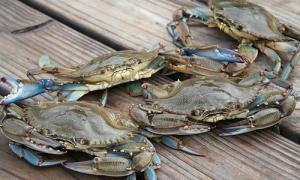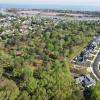Blue crab population decreases for second year
The availability and prices of Chesapeake Bay blue crabs have varied throughout the early summer months, which has been attributed to many influences; most notably the reported 18 percent decline in population.
If there is an increase in price for crab dishes at local restaurants or eateries, or when buying crabs from a roadside vendor, the direct consequences of supply and demand will be seen. This is something occurring throughout the Eastern Shore as well as up and down the coast where restaurateurs and fishing distribution centers rely on the availability of blue crabs.
According to the Blue Crab Advisory Report released June 27 by the Chesapeake Bay Program and developed by the Chesapeake Bay Stock Assessment Committee, the overall Chesapeake Bay blue crab population has decreased by almost 18 percent, from 455 million in 2017 to 372 million in 2018.
Resource managers involved in this study use scientific reference points for determining the "target" (healthy) and "threshold" (border between safe and unsafe) levels to draw conclusions on the state of the population. By following this method, scientists have determined that the current population is not being overfished or depleted; noting that there is no need for concern at this point in time.
The Blue Crab Advisory Report gathers data from the Maryland Department of Natural Resources, Virginia Marine Resources Commission, the Potomac River Fisheries Commission, various fisheries and data to determine the numbers released on their reports each year. This data is gathered and analyzed along with the annual Bay-Wide Winter Dredge Survey and harvest estimates from previous years to determine the current state of the blue crab in the Chesapeake Bay area.
Some other notable points from this report include: 147 million female blue crabs was off from the target of 215 million for this year (this is important to the future success of the species given the ability to reproduce, so females draw a greater attention in the success of population increase or decrease); the number of juvenile crabs has increased by 34 percent from 2017 to 2018 (which will grow to a harvestable size this coming fall); the adult male blue crab population has decreased from 76 million to 58 million; and the higher water temperatures have had an effect on the mortality rate. This report also includes recommendations for jurisdictions to maintain a cautious and risk- averse approach to harvesting this year like years in the past. It also suggests an implementation of procedures that provide accurate accountability of all commercial and recreational harvest operations to help enable more accurate future assessments of the Chesapeake Bay blue crab.
The releasing of these figures is an effort to maintain a sustainable blue crab population, and help inform government agencies, fisheries and the public of the studies that are being conducted to monitor the health of the specific species that also have a direct effect on the unique ecosystem in the Chesapeake Bay Region.
Not only are blue crabs an integral part of the ecosystem, but also a large part of the economy in the region. Commercial and recreational fisheries have paid attention to the numbers and have harvested less in 2017 than 2016 overall.
Despite the report reflecting a decreasing population from 2017 to 2018, experts from multiple agencies want people to know there is no cause for alarm at this point in time.
"Through the science in the Blue Crab Advisory Report, resource managers around the bay have information and analysis they need to make informed decisions about blue crab fishing regulations. This year's report indicates we're on a solid path and, thanks to the science involved, can enjoy eating crabs with friends and family this summer," said Sean Corson, acting director, NOAA Chesapeake Bay Office and chair, Sustainable Fisheries Goal Implementation Team.
The Eastern Shore will be able to indulge in a summer tradition of eating crabs with friends and family, whether at home in the backyard or at a favorite restaurant, without paying a premium; the early summer months are just the beginning of the crab season.
For the full 2018 report, visit: www.chesapeakebay.net/documents/CBSAC_2018_Crab_Advisory_Report_Final.pdf.






















































